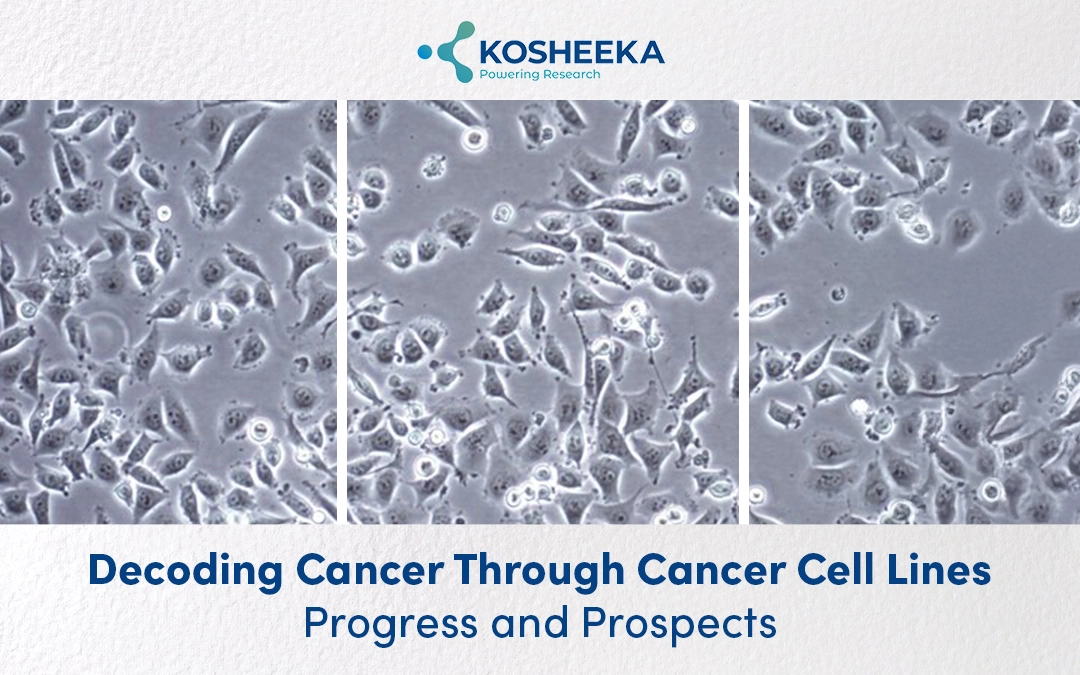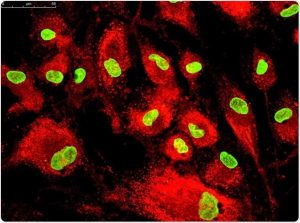Cancer cell lines have served as reliable in vitro models for cancer research. They have incremented our knowledge about tumor pathogenesis and contributed to the development of therapeutics. These cells are easy to maintain in the culture conditions with minimum requirements, adding to their cost-effectiveness. Over the years, several animal and human cancer cell lines have been extracted from diverse tissues and employed for in vitro research.
However, in recent years, several limitations of these lines have surfaced, raising doubts about their clinical relevance. It has created a dilemma in the scientific community for their applications. Nonetheless, being the most accurate in vitro platform for oncology, continues their use in laboratories.
Human Cancer Cell Lines
Until the 1950s, scientists had been isolating primary cells and optimizing media formulation to enable their in vitro culture. The short lifespan and diverse media requirements have made the task challenging. And it all changed in 1951 with the culture of HeLa cells. It was a significant milestone, as it facilitated easy maintenance in culture and the study of cancer biology. Since then, many such cells have been extracted from Tumor Tissues.
In 2012, two independent groups- Garnett et al. and Barretina et al. – published results of a comprehensive characterization of tumor lines. They demonstrated that these cells comprise the genetic profile and diversity of their corresponding tumor tissue. Both groups concluded that these cells accurately reflect tumor characteristics.
Types of Cancer Cell Lines
A tumor cell line can be classified on different basis such as tissue type, species, and culture characteristics.
Classification by Tissue Specificity
- Hematopoietic Lines: These originate from hematopoietic tissue or hematological cancers, such as lymphoma, leukemia, and myeloma. Eg., K562, NB4, THP1.
- Pancreatic Cancer Cell Line: These include cells derived from pancreatic cancer in exocrine (PaCa2, PANC1) or endocrine (MIN6) regions.
- Breast Carcinoma Line: Cells, such as MCF7, BT20, and HCC1937 are available for research into breast tumorigenesis.
- Liver Cancer Cells: HepG2 is the most widely used hepatic line, which makes it possible to investigate hepatocellular cancer.
In addition to the above cells, several other tissue-specific lines from skin, lungs, prostate, ovary, bones, etc., have enhanced our understanding of cancer.
Classification by in Vitro Characteristics
- Adherent: These cells are dependent on a substrate to attach or grow. They create monolayers on the culture dish. For example, HEK293, HeLa,
- Suspension: Cells float in the medium and do not require adhesion to the culture dish. Independence from the surface attachment allows for more population doubling and cell quantity than adherent cells. E.g., HL60, K562, Jurkat, etc.
Disadvantages
The culture of cancer cells has been much easier than that of primary cells due to the indefinite lifespan of the former and less media requirements. However, they also have drawbacks that caution their off-hand application in studies.
- In 1981, Walter-Nelson Reeds reported the first cross-contamination in cancer cells in the laboratory from other tumor cells. Soon after, several other laboratories described the exact incidence. The cross-contamination may occur due to improper handling, sharing pipettes, media, or reagents between cells, mislabeling of culture dishes or vials, or use of conditioned medium containing contaminating cells. It has also led to the cell line misidentification, leading to the retraction of many research papers based on them. Two techniques- STR profiling and SNP assay- are now employed for adequate characterization of these cells.
- The majority of the cell lines originate from metastatic tumors, which does not permit the study of cancer progression. Furthermore, the translation potential of these models has been limited due to their slight divergence from the original tumor. However, the early-stage tumor cell line is more similar to the tissue, which makes it a more potential platform.
- The absence of tissue microenvironment, including immune cells, cytokines, and native tissue structure, can affect the cell line growth and behavior in culture. Additionally, their culture for longer periods induces genetic drift that causes variation from the tumor tissue. Several studies have shown that cell lines in culture have more similarity than a clinical sample. These inferences suggest the use of 3D culture of cell lines for a more accurate tissue representation.
- Tumor tissue displays substantial heterogeneity. It only elevates when accounting for individual variation in the tumor. Cell lines belonging to different patients have diversity in terms of genetic, phenotypical, epigenetic, and transcriptional factors. Typically, culture conditions do not support heterogeneity, only sustaining a few diverse cells.
- There have been contradictory studies claiming that tumor cell lines do not mimic the tumor features. Cancer Cell Line Encyclopedia (CCLE) showed that expression of markers such as TP63 (lung adenocarcinoma marker) and TTF1 (squamous carcinoma marker) is similar between two adenocarcinoma and squamous cell lines. Many studies also demonstrated that drug response and sensitivity differ between cell lines and tumor tissue.
Applications
Despite their shortcomings, these continuous cells have contributed considerably to cancer research.
- Drug Discovery: Studying cancer lines revealed pathways essential for tumor growth. For instance, the impact of retinoic acid on PML-RAR alpha fusion was found while analyzing the NB4 cell line. The first tyrosine kinase inhibitor for cancer- imatinib was developed as a result of research on the K562 cell line that revealed the presence of Bcr-Abl fusion. The National Cancer Institute (NCI) utilized 60 different Cancer Cell Lines for screening compounds for anti-cancer activity. It led to the discovery of several chemotherapeutic agents such as cisplatin, paclitaxel, fludarabine, etc.
- Drug Sensitivity: Tumor tissue often displays resistance to chemotherapeutics. Predicting drug response and sensitivity before treatment on a cell line can aid in treatment optimization. Numerous investigations have examined a wide range of substances on various cell lines in order to assess response and the ensuing gene alterations. The advent of personalized medicine has progressed the tumor therapy. It entails evaluating drug response on cell lines derived from patients prior to treatment. In the long term, it can prevent the administration of ineffective medications and their adverse effects on patients while also modifying treatment to ensure maximum benefits.
- Diagnostics: Tumor diagnostics are an underestimated component of treatment. The fact is that early detection of tumors results in timely treatment and less mortality. Therefore, the discovery of biomarkers is an essential aspect of cancer research. In recent years, this field has further progressed with the incorporation of omics data. The presence of a specific gene signature increases the susceptibility of the tumor. Many companies provide an evaluation of the tumor gene panel and estimate the risk of the tumor. For example, BRCA1 mutations make females prone to breast cancer. Such analysis can act as an early detection system.
Future Perspectives
The burden of cancer has increased significantly over the past years, primarily due to a lack of effective treatment modalities. The identification of the pertinent signaling pathways for drug development has stimulated research on cancer cells. However, years of research have stated that these lines might not represent the tumor tissue behavior and heterogeneity with utmost accuracy. It is paving the way for tumor organoids, patients’ xenografts, and gene editing techniques for more reliable results. Nevertheless, human cancer cell lines are still the center of cancer research. Kosheeka delivers these cell lines, accelerating cancer research.
FAQ’s
Q-What is cancer cell line and its application in research?
It refers to cells derived from tumor tissues and cultured in laboratory conditions. They allow scientists to study cancer biology, test drug efficacy, and investigate tumor mechanisms.
Q-What are the advantages of a cell line over primary cells?
A cell line has an indefinite lifespan, requires simpler culture media, and is easier to maintain compared to primary cells. This makes it cost-effective and suitable for large-scale experiments without the frequent need for fresh tissue samples.
Q-What are the limitations of a cancer cell line?
Limitations include cross-contamination, genetic drift over long-term culture, lack of tumor microenvironment elements, and differences in drug responses compared to actual patient tumors. Additionally, many of these cells originate from metastatic cancers, limiting studies on early-stage tumor progression.
Q-What are the future alternatives to a tumor cell line?
Emerging alternatives include tumor organoids, patient-derived xenografts, and gene-editing technologies. These models aim to replicate tumor heterogeneity and microenvironment more accurately, increasing clinical relevance for drug development and personalized medicine.



